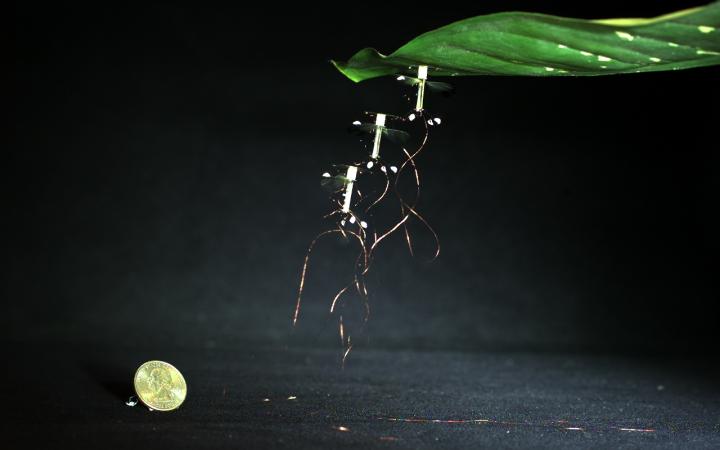Flying robots use static electricity to stick to surfaces
A team of roboticists from Harvard is offering flying robots some new capabilities.
Inspired by nature and simple science, the team developed a set of Robotbees, microrobots that can actually perch during flight to save energy, in the same way that bats and birds do.
“Many applications for small drones require them to stay in the air for extended periods,” said Moritz Graule, first author of the paper who conducted this research as a student at the Harvard John A. Paulson School of Engineering and Applied Sciences (SEAS) and Wyss Institute for Biologically Inspired Engineering at Harvard University. “Unfortunately, smaller drones run out of energy quickly. We want to keep them aloft longer without requiring too much additional energy.”
According to Kevin Ma, a post-doc at SEAS and the Wyss Institute, a lot of animals in nature use perching in order to save their energy. However, their methods, using sticky adhesives or their talons, are not exactly applicable to tiny robots the size of a paperclip.
Instead, the team decided to employ electrostatic adhesion , that uses the same principle as the static that causes a balloon to stick to a wall.

When you rub a balloon on a wool sweater, the balloon becomes negatively charged. If the charged balloon is brought close to a wall, that negative charge move some of the wall’s electrons away, which leaves the surface positively charged. This attraction between opposite charges causes the balloon to stick to the wall.
“In the case of the balloon, however, the charges dissipate over time, and the balloon will eventually fall down,” said Graule. “In our system, a small amount of energy is constantly supplied to maintain the attraction.”
To employ the same method to its RoboBee, the Harvard Microrobotics Lab used an electrode patch and a foam mount that absorbs shock. The entire system, weighing just 13.4 mg, brought the total weight of the robot to about 100 mg, which is approximately the same weight as a real bee.
When the robot takes off for flight, the electrode patch was supplied with a charge, allowing it to stick to almost any surface, such as glass, wood, and a leaf. In order to detach from the surface, the power supply must be switched off.
“One of the biggest advantages of this system is that it doesn’t cause destabilizing forces during disengagement, which is crucial for a robot as small and delicate as ours,” said Graule.
The patch that makes the robot stick requires about 1000 times less power to perch than it does to hover, which extends the life of the robot. Since the robot now requires less power, the researchers can now focus on incorporating on-board batteries into the RoboBees.
“The use of adhesives that are controllable without complex physical mechanisms, are low power, and can adhere to a large array of surfaces is perfect for robots that are agile yet have limited payload – like the RoboBee,” said Robert Wood, Charles River Professor of Engineering and Applied Sciences at SEAS and a core faculty member of the Wyss Institute. “When making robots the size of insects, simplicity and low power are always key constraints.”
Currently, the RoboBee’s electrostatic patch is located on the top of the vehicle, so it can only perch under overhangs and on ceilings, but the team wants to change the mechanical design so that the robot can perch on any surface.
“There are more challenges to making a robust, robotic landing system but this experimental result demonstrates a very versatile solution to the problem of keeping flying microrobots operating longer without quickly draining power,” said Ma.
Story via Harvard University.


Comments are closed, but trackbacks and pingbacks are open.